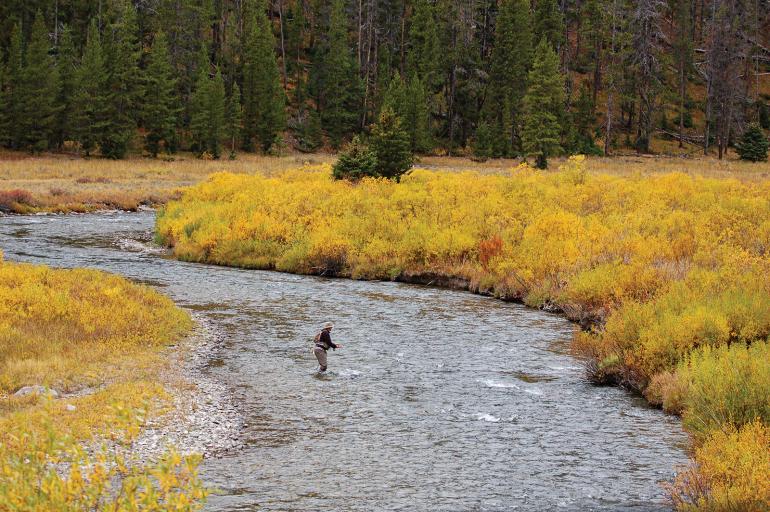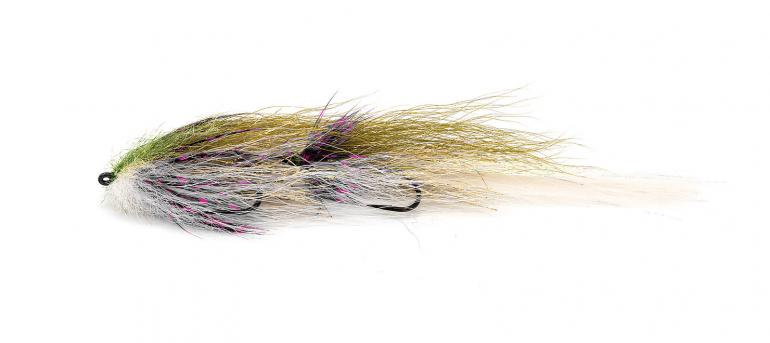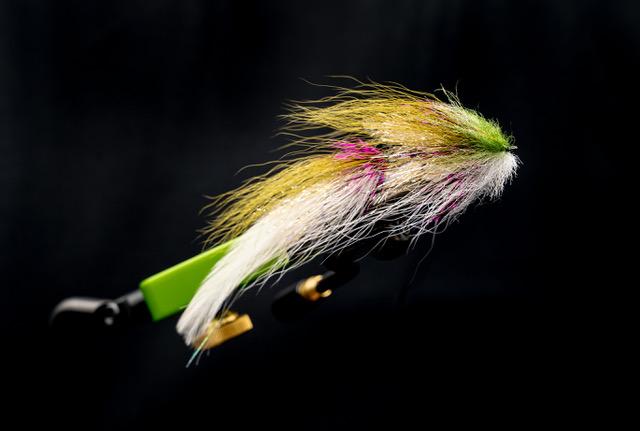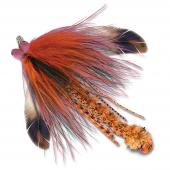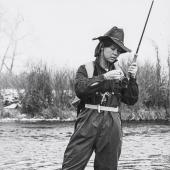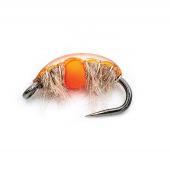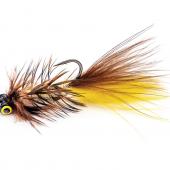Trick & Treat
Tying the brush-head double deceiver.
There are many ways to catch trout in the fall, but stripping a big, flashy, articulated streamer might be the most fun. As the water cools and the trout prepare for winter, they become territorial, feeding aggressively on larger food. The lightweight “brush-head double deceiver” is a great fly for the low, clear water in the fall. Its combination of bright colors, flash, and the water-push from the brush-head make this fly hard to ignore for big, aggressive trout.
Materials
- Hook: Ahrex TP610 #1 (rear), Ahrex TP610 #1/0 (front)
- Thread: Veevus GSP 100D, white
- Tail: Strung Saddle Hackle, white
- Flash: PolarFlash, mirage opal
- Body: UV Polar Chenille, gold UV
- Wing: Bucktail, olive (top), white (bottom)
- Collar: Strung guinea feathers, hot pink
- Hook Connection: Senyo’s Intruder Trailer Wire, large, black
- Spacer Bead: 3D beads, gray
- Head: Sculpting Flash Brush 2”, white
- Adhesives: Solarez Bone-Dry, clear
Instructions
1. Attach thread to hook and wrap a thread base down the shank until the shank starts to bend down.
2. Select two similarly-sized saddle feathers and marry them together, with the concave sides of the feather facing each other. Strip barbules off each side of the stem so you have 3-4.5 inches of feather remaining from the tips. Tie both feathers in simultaneously with the stems, directly on top of the hook shank, so that the feathers extend beyond the hook. The hackles should be in line vertically with the hook.
3. Take 4-8 strands of PolarFlash and tie in just before the hackle stems on top of the hook shank. Take your thumbnail and press down into the fibers on the hook shank to spread half the fibers onto one side of the tail and half onto the other side. Trim flash slightly longer than hackle tail.
4. Tie in UV Polar Chenille and wrap up the body with touching wraps until you reach two hook-eyes in length behind the eye of the hook. Trim excess.
5. Snip about half a pencil-width of olive bucktail and tie in on top of hook shank, with the tips extending to about half the length of the hackle tail. Snip an equivalent amount of white bucktail and tie in on the bottom side of the shank, even in length with the olive bucktail.
6. Select a guinea feather and strip the fuzzy fibers from the stem. Tie in the tip of the feather just in front of the bucktail tie-in point and wrap forwards until you reach the eye of the hook. Trim excess and build up a small thread head. Whip finish and snip your thread. Apply Solarez Bone-Dry to seal your thread wraps.
7. Place the front hook into the vise and attach your thread. Snip 4-5 inches of Intruder Wire and attach to the top of the hook shank. Wrap rearwards until you reach slightly down the bend of the hook. Slide one 3D bead onto the wire, then thread your rear hook onto the wire. Take the tag-end of your wire and slide it back through the bead, creating a loop. Your loop should be roughly the size of the 3D bead. Tie down the tag-end of the wire to be even with the first section, and wrap up the hook shank until you reach about the 2/3 mark of the hook. Ideally, you have excess wire from both ends facing forwards. Fold excess wires backward, wrapping thread to hold them down, creating a secure connection. Snip any excess and apply Solarez Bone-Dry to the whole shank to make sure the wire can’t be pulled out.
8. Tie in Polar Chenille and wrap up the hook shank with touching wraps until you cover about 2/3 of the shank. Snip excess.
9. Repeat step 5, making the length of the bucktail extend to halfway down the rear hook wing.
10. Select another, slightly larger guinea feather and strip the fuzzy fibers from the bottom of the stem. Tie in the tip of the feather right in front of the bucktail tie-in point and wrap the feather until you run into the bare stem. Snip excess and wrap back over the feather so that you have around two hook-eyes worth of space in the front of the fly.
11. Tie in the Sculpting Fiber Brush and wrap forwards to the hook eye (3-5 wraps). Tie off the brush and snip the excess. Whip finish and snip your thread. Seal the thread with Solarez Bone-Dry. Comb out fibers to free any trapped bits and trim to roughly match the flare of the front bucktail wing.
12. Run your fly under the sink to get the fly wet, then hang-dry vertically. This will tame the bucktail and show you the true shape of the fly.
Jacob Pehl is the assistant manager at Bozeman Fly Supply.


